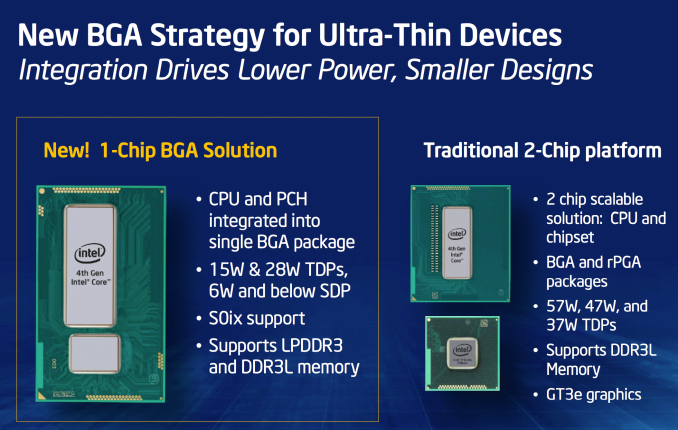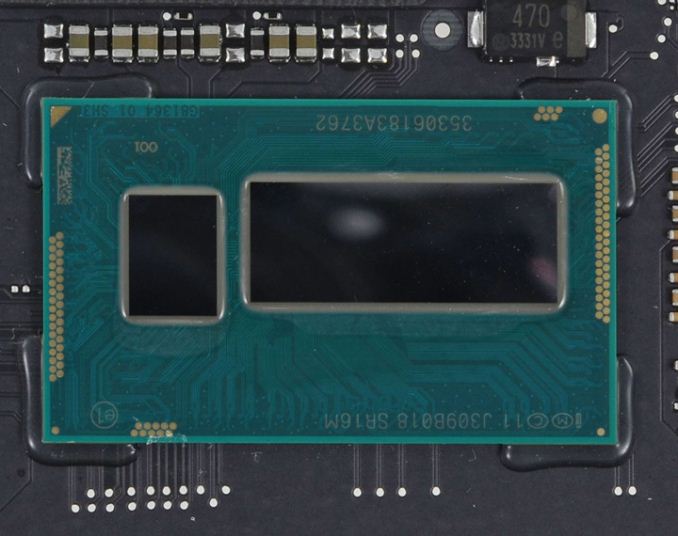The 2013 MacBook Air Review (13-inch)
by Anand Lal Shimpi on June 24, 2013 12:01 AM ESTThe CPUs
Apple keeps things simple across the 2013 MacBook Air lineup by configuring both 11 and 13-inch models with the same base CPU: a Core i5-4250U.
To understand Apple’s CPU choice, you have to understand that Apple is primarily concerned about improving battery life this generation. The line between MacBook Air and MacBook Pro has to be well defined. The Air is about portability, while the Pro is about performance. When faced with a power/performance tradeoff, it’s clear on which side of the fence Apple will fall whenever the MacBook Air is concerned.
| Apple 2013 MacBook Air CPU Comparison | |||||
| 1.3GHz dual-core | 1.7GHz dual-core | ||||
| Standard On | 11 & 13-inch MBA | Optional on Both | |||
| Intel Model | Core i5-4250U | Core i7-4650U | |||
| Base Clock Speed | 1.3GHz | 1.7GHz | |||
| Max SC Turbo | 2.6GHz | 3.3GHz | |||
| Max DC Turbo | 2.3GHz | 2.9GHz | |||
| L3 Cache | 3MB | 4MB | |||
| TSX-NI | No | Yes | |||
| TXT | No | Yes | |||
| AES-NI | Yes | Yes | |||
| VT-x/VT-x EPT | Yes | Yes | |||
| VT-d | Yes | Yes | |||
| TDP | 15W | 15W | |||
| Processor Graphics | Intel HD 5000 | Intel HD 5000 | |||
| GPU Clock (Base/Max) | 200/1000MHz | 200/1100MHz | |||
The lower base clock alone shouldn’t mean much, but the max TDP of the CPUs in the new MacBook Air falls as well - from 17W down to 15W. The thermal limit is even more dramatic since with Haswell ULT, the 15W includes the CPU/GPU as well as the on-package PCH. In Ivy Bridge the PCH was off package and wasn’t included in the 17W TDP.
Max turbo clocks are identical between the Haswell ULT CPUs Apple picked this round and the Ivy Bridge models before, but with a lower TDP it’ll be harder to always sustain the same frequencies given the right workload.
Haswell does feature a not insignificant gain in IPC compared to Ivy Bridge, which should help offset the power constraints that could otherwise force a larger regression in performance.
Both 2013 MBAs ship with the same CPU by default, and both can be upgraded to the same higher end SKU: a Core i7-4650U. The 4650U retains the same 15W TDP as the i5-4250U, but it increases its base clock speed to 1.7GHz and max turbo to 3.3GHz. The L3 cache also grows from 3MB to 4MB. All in all, this should be a very healthy upgrade in performance. Intel likely maintains the same TDP by binning for power; the i7-4650U is probably capable of running at higher frequencies without any appreciable increase in voltage. The max GPU clock also goes up by 10%.
Haswell ULT, Courtesy iFixit
What's arguably coolest about the i7-4650U is it enables Haswell's Transactional Synchronization Extensions (TSX-NI), a feature which is unfortunately disabled on the i5-4250U. I don't suspect this will matter much for most MBA users, but anyone looking to play around with Haswell's TSX instructions will want to opt for the higher end SKU. The upgrade costs $150 regardless of base model. Intel charges $454 for the i7-4650U and $342 for the i5-4250U, a difference of $112; Apple is adding another $38 onto the 1KU pricing, which isn't unreasonable.
Many have asked me what the impact of the i7 will be on battery life. I'm hoping to get my hands on an i7 based machine when I return from the UK in a week, but for those of you making immediate decisions I'll offer the following. Sustained operation at higher frequencies will likely draw more power, and negatively impact battery life. Light to medium workloads will enjoy a mix of race to sleep benefits as well as higher power consumption under load. Idle power should be roughly similar between the parts however. For most workloads I'd expect a modest impact to battery life, but it won't be enough to regress to 2012 levels of battery life. All of this is said without knowing key details like operating voltage for most 4650Us. I plan on addressing that shortly.












233 Comments
View All Comments
arkhamasylum87 - Monday, June 24, 2013 - link
Broadwell will have a refreshed GPU architecture and with the process shrinks, the gains would be more amenable to all. Although the intent to raise the GPU perf a decent percentage with dedicating more than the half the die is a big time change at Intel.rmr - Monday, June 24, 2013 - link
Hi Anand,Good review! I'm waiting for the updated review (using the i7 processor). BTW will it be possible for you to test the Air with an older 802.11g router (since some people have been complaining in the Apple forums about the Air dropping Wifi connections)? I was planning to get a new MBA but I'll be mostly using it at locations with older .11g routers.
Thanks.
Regards,
rmr
scyap - Monday, June 24, 2013 - link
Did the writer mention what OSX version was used for testing? Or I missed out?If this review was using Mountain Lion, should I expect even better battery life in Mavericks?
xype - Tuesday, June 25, 2013 - link
Yes, you should. Every dev I know who runs on Mavericks reports 10-20% better battery life (that's mighty subjective and unscientific, but I am sure AnandTech will do a proper test).Personally I'll make use of my dev account and upgrade as soon as all the dev tools I need are confirmed a running (homebrew-installed stuff mostly).
Ricopolo - Tuesday, June 25, 2013 - link
Anand, love your site. But your constant use of acronyms (like PCH, TDP, etc) that are non-household terms can be quite an obstacle to lay people, who are interested in gaining a bit of insight in tech development. Can you put together a glossary for these acronyms and put it in the footer or somewhere obvious?Thanks a lot.
SkylerSaleh - Tuesday, June 25, 2013 - link
PCH stands for Platform Controller Hub. It provides some needed utilities required to run the CPU correctly, such as display handling, connecting peripherals, DMI, etc. As a lay-mans example, the PCH supports the CPU's operation, similar to how your subconscious supports your operation. Taking over the responsibility of semi-voluntary/non-voluntary actions like breathing, so that you can think about other things.TDP stands for thermal design power. It is a measurement of the maximum amount of cooling that is needed to cool a chip in its worst case. As a rule of thumb, the higher the TDP, the more power the chip will use at peak. (However this is not a good measurement of power usage when idle.)
name99 - Tuesday, June 25, 2013 - link
Google shows up the obviously correct results for both of these very high in its list.If you want even cleaner and simpler results search on wikipedia.
I don't want to be a dick, but part of Anand being a fairly high-end site (including, for example, the variety of technical details which make it substantially more interesting than a Macworld or The Verge or WSJ review) is that it consists of an engineering aware community, which speaks in its natural language, just like any other community.
If you wish to be part of that community, the solution is not to complain that they use unfamiliar language, but to familiarize yourself with that language. It's not hard --- more so than ever before in the past you can learn what you need to just by scanning Google and wikipedia. And if you want to understand more details, again it's easier than its ever been before --- just look over the review articles either on this site, on Ars Technica (for the simplest introduction) or on David Kanter's Real World Tech (for the most sophisticated introductions you can probably get for free on the internet).
jb510 - Wednesday, June 26, 2013 - link
Well said. It's worth noting that even some of us very technical folks have to look up a lot of terms and acronyms reading here as the spectrum of content is so broad. However, I greatly prefer the clean without reference to terms style of AT to the cumbersome reading if copy that is interrupted constantly to define things. Unless you're reading the print edition of AT, the whole internet is just one click away.robco - Tuesday, June 25, 2013 - link
The updated Airs seem pretty sweet. I use my laptop as my primary machine, so I'll probably wait for the rMBP to get updated. I'm also curious to see how well the Iris 5100 graphics compare to the HD 5000. An IPS display would have been a nice upgrade, but I can see why Apple decided to make upgrades in other areas instead.The WiFi snafu is interesting. I'm not sure if Apple missed it, or figured it would be a while before most users would upgrade to ac and decided to go ahead and ship it in time for WWDC. As for battery life, even the numbers under heavy workload are impressive for such a small machine. I'm curious to see how well the battery life numbers improve for other ultrabooks as they switch to Haswell running different OSes. I would also like to see if or how well battery live improves after OS 10.9 is released this fall.
Abelard - Tuesday, June 25, 2013 - link
Thanks for the thorough review, Anand. The battery life you were getting is very impressive.I'm curious how the MBA will perform running OS X Mavericks, though. Developers and early adopters seem to be reporting battery life improvements. It's possible Mavericks could squeeze another hour or two out of the 2013 MBA.